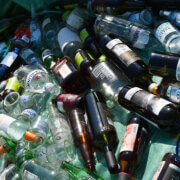Glass Recycling is Back Thanks to One Person Who Volunteered
By Cathy Kuehner
Thanks to one county resident who is passionate about recycling and reusing material rather than adding it to landfills, other residents can now drop off glass for recycling at the Clarke County Convenience Center on Quarry Road
(Route 612).
Christi McMullen, who lives in the northeast part of the county near the facility for household trash, recently purchased an Expleco glass bottle crusher. It cost her about $7,000. She also purchased a small trailer and heavy-duty liners that make it easier to remove bottles from the trailer. Currently, she sifts the crushed glass by hand, but hopes to one day buy a mechanical sifter for $11,000.
Each weekend in May, McMullen placed her trailer at the Convenience Center as part of a county-approved pilot program. The two unknowns were the level of community support for recycling and the cleanliness of the glass deposited in the trailer.McMullen and county administration are thrilled with the initial results.
Over four weekends, residents placed 2,413 clean glass bottles and jars in McMullen’s recycling trailer. This represents about 2,000 pounds of recycled glass. Those bottles did not go to the landfill; they were ground into reusable sand, and those repurposed bottles saved money for the county.
Joey Braithwaite, county maintenance director, explained, “When the trash compactor is pulled and taken to the Frederick County landfill, Clarke County is charged by weight. With a glass recycling program, the dumpster’s weight will be significantly reduced, which reduces expenses for the Center’s operations.”
Reducing county expenses is good but keeping recyclables out of the landfill is even better. “Clarke County was never able to recycle glass, and when the Convenience Center opened in January 2019, there was no place locally that accepted glass,” Braithwaite said.
Glass is 100 percent recyclable, and it is infinitely recyclable without loss in quality; however, only about 33 percent of glass is recycled in the U.S. Virginia recycles about 10 percent. Why? Glass is heavy and expensive to transport to recycling centers. When glass is tossed into recycling bins, it breaks into bits that are difficult to separate out for recycling. And, since China stopped accepting U.S. recyclables in 2018, recyclers here are increasingly focused on quality and reducing contamination to maintain the value of their recyclable materials.
Many people feel good about placing paper, cardboard, plastic, and glass into recycling bins. But, when other people place materials contaminated with food residue and other trash into recycling bins, it all becomes trash and it all goes to the landfill.McMullen wants to improve the glass recycling rate — at least in Clarke County. “Anyone could buy a glass-crushing machine and do this, too,” she said. “It isn’t hard, but it requires community support.”
Glass is made from sand, and using the glass-crushing machine, McMullen can turn glass bottles and jars back into sand. Once McMullen unloads bottles at home, she sorts it by color, and removes any metal rings that may still be on bottle necks. She places one bottle at a time into the crusher and sifts the crushed glass into different grits or “cullet.” Larger cullet is good for art projects or decorative concrete. Finer grit — coarse sand — can be used in gardens to keep soil moist. The finest cullet is sand, which can be used for children’s sandboxes, flood-prevention sandbags, sandblasting machines, and replenishing beaches affected by coastal erosion. It takes 160 bottles to fill a 5-gallon bucket with fine sand.
Since purchasing the glass crusher in April, McMullen has given away most of the cullet she has made. “We hope to get sand to people who can use it, but it will take a lot of people and more machines to crush all the bottles and jars that would otherwise would go to the landfill,” she said. “I’m not doing this to make money,” McMullen said. “I’m doing this to make
a difference.”
McMullen wants to be clear. “This is not a recycling business. It is a volunteer project because I love recycling.”
McMullen and her husband John used to move every four years or so because of his work. Now that John is retired, the McMullens have called Clarke County home for the past six years. “We try to give back to our community wherever we live,” she said.
“We are grateful to Christi for coming forward with this idea and being willing to volunteer her time and resources,” said Clarke County Administrator Chris Boies. “This is still a pilot program. At this point we are still evaluating the need and various logistical components of the program.”
Still, Boies hopes McMullen’s glass recycling trailer becomes a fixture at the Clarke County Convenience Center.For the glass recycling project to be successful and continue, all glass deposited in the trailer must be clean. All lids, caps, and corks must be removed. Paper labels are OK. Do not put mirrors, windows, heat-tempered glass such as Pyrex and mixing bowls, ceramic mugs and plates, wine glasses, etc., in the trailer.“
Anybody can reduce the amount of glass that ends up in landfills,” McMullen said. “We can make a big impact in a short amount of time.”
Find more information on McMullen’s Facebook page: Glass Recycling Clarke. Contact her at glassrecyclingclarke@gmail.com.
Read more about the Clarke County Convenience Center, including its hours of operation, at www.clarkecounty.gov/
residents/trash-recycling.
Solar Energy Sweeps Into The Valley
My son and I were watching Doctor Who. It was an episode with Daleks. The Dalek armor, he said, always reminded him of Roman shields, a technology the Romans used pretty much unchanged for hundreds of years. “That’s just weird,” he said. “Now things change every year.” He is 15 years old.
It does seem sometimes like things change overnight, but more often a tipping point is reached after years or decades of incremental advance. The efficiency of solar-electricity generation has improved exponentially over four decades. Now look.
In 2021, according to the Solar Energy Industries Association, solar made up more than half of all new electricity generated in the U.S. during the first three quarters. By 2050, renewable energy will make up nearly half of all electricity generation, and half of that will come from solar.In Virginia, 416 projects are awaiting review by relevant agencies. Those projects have potential power capacity of 22,679 megawatts (enough to power 3.7 million homes), according to a recent article in Bay Journal. PJM, the manager of our regional grid, is so swamped with applications from operators to join the grid that it has had to pause the process to come up with a plan. Clearly, the solar future has arrived.
There is a Wild West atmosphere in solar development. In the name of sustainability, developers have cleared thousands of acres of forest to plant “clean energy.” This, while federal, state, and local governments are spending millions on tree plantings to clean waterways and mitigate global warming.
There are questions about compatibility with the agricultural landscapes that many private and public entities have worked to preserve. And questions about how the massive introduction of pervious surfaces will impact water quality — again, when so much is being invested to manage stormwater runoff that destroys rivers and streams.
There is a lot we must figure out, with not much time to spare. This year, the Virginia legislature, supported by conservation organizations, passed a measure establishing reasonable standards in the permitting process, recognizing the importance of farmland and forests, and requiring mitigation when significant impact occurs. A good start.
These are exciting times. Solar and wind energy are accelerating. Major carmakers are moving toward all-electric fleets, which will increasingly be powered by electricity from cleaner sources.
After all these years, the large-scale use of solar energy to power our homes and businesses is not a technological quandary. It’s a planning challenge and, for now, a race to manufacture and deploy as quickly as we can.If we’re lucky, time travelers like Doctor Who will one day visit 2022 to see our exciting beginnings, as we created the systems that gave them the wonderful planet they inhabit.
— David Lillard



